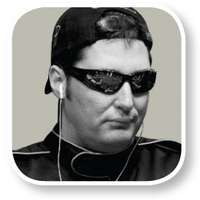






‘The Mouth’ Attempts a Big Bluff‘The Mouth’ Attempts a Big Bluffby Phil Hellmuth | Published: Jun 15, 2011 |
|
|
 A few months ago, I watched the final table of the World Poker Tour tournament at Bay 101 as Mike “The Mouth” Matusow went for the win. Late in the day, with four players remaining at the table and the blinds at 15,000-30,000, and a 5,000 ante, Matusow (1.8 million in chips) opened for 70,000 from under the gun with the A♣ 10♦, and Alan Sternberg (3.7 million in chips) called with 4-4 from the button.
A few months ago, I watched the final table of the World Poker Tour tournament at Bay 101 as Mike “The Mouth” Matusow went for the win. Late in the day, with four players remaining at the table and the blinds at 15,000-30,000, and a 5,000 ante, Matusow (1.8 million in chips) opened for 70,000 from under the gun with the A♣ 10♦, and Alan Sternberg (3.7 million in chips) called with 4-4 from the button.
The flop came down K♠ 9♥ 9♣, Matusow bet 85,000, and Sternberg called.
The turn card was the 6♣, Matusow checked, and Sternberg bet 125,000. After a minute, Matusow made a move and raised to 325,000 to go, and after about 30 seconds, Sternberg called.
The river was the 3♥, Matusow bet 500,000, and Sternberg quickly called.
I break this hand down here in this column and in full video format on the WPT website. Before I begin, I need to give some context to the hand. Matusow had not made a single bluff for hours, and was clearly the tightest player at the table. Matusow’s opening raise to 70,000, a little bit more than twice the big blind, is standard in 2011. It doesn’t mean that I like it, however. I would rather see a bigger raise — say, to three times the big blind (90,000). Sternberg’s call was fine.
Matusow’s 85,000 continuation-bet on the flop was OK by me, and is standard. Matusow’s check on the turn was OK; it looks like A-10 is not the best hand, so why not give up and lose 155,000? Sternberg’s 125,000 bet is interesting. Obviously, he thought that he had the best hand with his pocket fours. Thus, he thought that Matusow was weak, and because of this fact, I like Sternberg’s bet. Another two points that back up Sternberg’s bet are: First, by betting here, he freezes Matusow from making a bigger bet on the river if Matusow has a pocket pair higher than Sternberg’s, like J-J; second, he protects his hand from losing by forcing Matusow to fold hands like A-Q. On the other side of the coin, by betting here, Sternberg could put himself in a tough spot, because if Matusow raises, Sternberg probably has to fold, as he can beat only a bluff, and Matusow hadn’t bluffed all day long. So, Sternberg’s bet enables Matusow to make a move, or to charge Sternberg more if Matusow has him beat and raises. I like Matusow’s 200,000 raise on the turn, but I would prefer that he raised more — say, 400,000 or so.
I love Matusow’s 500,000 bluff on the river, for four reasons: First, Matusow had a good read (he told me that he thought Sternberg had a small pocket pair); second, Matusow had not attempted a bluff in five hours of play, so he had a strong image; third, Matusow bet the right amount — in other words, he bet as if he had A-K; fourth, Matusow’s 500,000 river bet showed a ton of heart and courage. I mean, Matusow fired three barrels (he bluffed three straight streets), and that’s a rare feat! Two facts worked against Matusow: First, the fact that Sternberg had already called a 200,000 raise on the turn made it more likely that he would call a 500,000 bet on the river; second, Sternberg had a lot more chips than Matusow had, so a 500,000 call wouldn’t put too big a dent in his stack. Give Sternberg maximum credit for a great read: He called a three-barrel bluff with a small pair. To sum up, Matusow’s strong bet was trumped by Sternberg’s strong read. ♠
Learn more about Phil by going to his website, www.PhilHellmuth.com, and visit his webstore at www.PokerBrat.com.
Features
The Inside Straight
Strategies & Analysis
Commentaries & Personalities